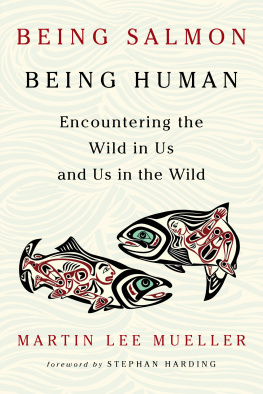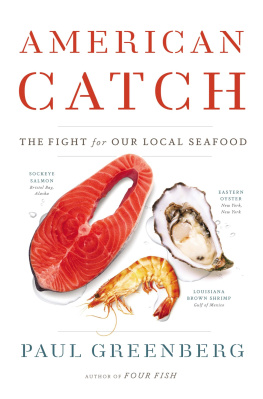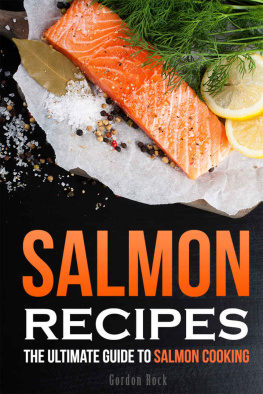
Toward Laerdal, Sognefjorden, Norway; fish market, Bergen, Norway; along the Sognefjorden, Norway
To Greg, my globetrotting salmon research companion I couldnt ask for a more wonderful mate
In so many ways Salmon has been the most extraordinary of all the books Ive written. When I began writing the proposal for this book, I decided that I would need to step out of the kitchen and away from my computer and travel to truly appreciate salmon. Not only did I want to taste salmon preparations from near and far, but I wanted to fish for salmon, visit Alaska for the opening of the Copper River salmon season, journey to Lrdal to see the most famous salmon river in Norway, and, finally, visit a certified high-quality salmon farm on the northwest coast of Scotland. Every aspect of researching and writing this book has been a wonderful and incredible journey.
Bill LeBlond, my editor and dear friend, is clearly at the top of my list for helping me develop this project. With every book I have received such skilled professional guidance, support, and time. Its a professional relationship beyond compare and one I cherish deeply.
To Amy Treadwell, Michael Weisberg, Michele Fuller, Kendra Kallan, Leslie Jonath, and the others at Chronicle Books who have inspired, supported, publicized, and otherwise kept my projects on track thank you, thank youyou are all absolutely delightful to work with. To Carolyn Miller, many thanks for copyediting another one of my books.
To Cheryl Russell, my fabulous assistant, I dont know what Id do without you. You make the process of developing and testing recipes a pleasure and loads of fun. I believe weve both grown gills working on this book, and I wouldnt be surprised to find a few scales still sticking to our skin! To my friends Harriet and Peter Watson, sharing our time together in Cordova, Alaska, was amazingly fun. Peter, thank you for all the gorgeous photographs and for taking my official author photo. But most of all, thank you for helping me reel in my 75-pound halibut. I can still hear your patient directions and words of confidence as I fought mightily to bring in my catch. And Harriet, I think we looked pretty darn cute in our matching fishing waders, fly rods over our shoulders, swishing our way through shallow water in pursuit of the perfect stream, bear sighting and all. There were so many firsts on this trip; it will always be a special memory.
To Kent Curly Herschleb and his terrific wife, Diane, I cant thank you enough for taking me on board (literally) and allowing me to experience firsthand what its like to be an independent wild-salmon fisherman. All the connections you helped me make were invaluable in writing this book. To Sylvia Lange and her husband, Greg Meyer, thank you for making our stay in Cordova, Alaska, such a wonder. To Phil Oman on the Bummaree, Danny Carpenter and his little dog, Daisy, on the Ambergris, and Paul Hearn on the SalmonMaster, it was great to meet you and share a spectacular beer and salmon dinner on the deck. To John Bosch at Copper River Seafoods, thank you for processing and packing up all that salmon and halibut for me to air-ship home.
In Norway, Id like to thank Lars Rtterud and Scott Givot for making our stay in Oslo such a fun and welcoming experience. Many thanks go to Helene Maristuen at the Norsk Villaks Senter in Lrdal for providing me with such a wealth of information.
In Scotland, many thanks to Julie Edgar, communications director for Scottish Quality Salmon, for all your tireless help and coordination of my trip. Special thanks to Gilpin Bradley of Wester Ross Salmon, Ltd. for showing me how salmon can be farmed responsibly to achieve a high-quality product. In addition, many thanks to Hugh Richards, Alistair MacLeod, and Mike Peterson, also of Wester Ross Salmon, for helping me understand all the quality-assurance factors involved in farming salmon.
Close to home, many thanks to all my friends and colleagues: Kate Morrison and Dave McElroy, Margie and Ken Sanders, Steve and Marci Taylor, Roxane and Austin Huang, Turid Owren, Pat Monroe, Paul Scardina, Summer Jameson, Audrey and Willie Anderson, Laurie and Peter Turney, Peter and Michelle Trumbo, Kam and Tony Kimball, Mary and Jack Barber, Sara and Erik Whiteford, Tori Ritchie, Josie Jimenez, Lorinda and Ray Moholt, Paola Gentry and Eric Watson, Tom Giese, Dennis Katayama, and all the folks involved with Salmon Nation. Many thanks to Eric Gorrell and Mike DeMarte at Liner & Elsen wine store in Portland for all their help with the wine suggestions.
Special thanks to David Watson for not only sampling my recipes and giving me genuine feedback but calling and saying, Diane, I just caught four steelhead. Do you want one? David, I promise you, the answer will always be Yes!
Finally, this book wouldnt have been nearly as much fun to research without my loving and supportive husband, Greg, sharing in all my travel adventures. To Eric and Molly, my children, thank you for all your love and support every step of the way. And, Molly, I am now done developing and testing salmon recipes, so you wont need to say, Oh, Mom, not salmon again.

I share Dianes awe of salmon. I first came to know this magnificent fish when, as a little kid, I went fishing with my father in northern California. Wild-salmon season opens in early spring, when the fish begin their migration back to their freshwater birthplace. Wed get our gear together, book ourselves on a boat, and head out into the usually very foggy, very rolling seas off San Franciscos Golden Gate. Ive never forgotten this annual ritual of fishermen and fish. This was when I first began to understand and appreciate the annual dramas that occur in nature and their connection to what we eat. Any of us who have been lucky enough to grow up in a food-producing or -gathering family I suspect also share this appreciation of natures rhythms.
This drama profoundly affected what I chose to do later in life as a chef. I have long espoused (as have many others) that food is best when it is gathered or harvested during its prime season, as close to home as possible, and in as natural and pristine a state as we can find it. Its what I call ethical food and has been a mantra of mine since I opened my namesake restaurant in Sonoma County, California, nearly twenty-five years ago.
An unfortunate fact, at least in my mind, is that many of us have no real idea of how our food comes to us. We live in a time when almost everything is seemingly available to us all year round. Natures rhythms, if we were ever aware of them, have been forgotten for the most part. Dianes book gently reminds us that eating is a direct act of participation in these cycles and rhythms, whether we are conscious of that or not. I call your attention especially to her discussion on the merits of wild versus farmed salmon. Several recent reports and articles have raised both ecological and health concerns about farm-raised salmon. Diane provides an evenhanded look at this controversy and helps us to understand how to make responsible choices.

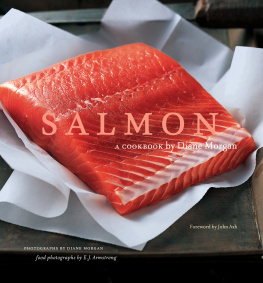
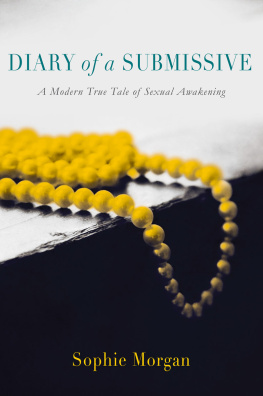



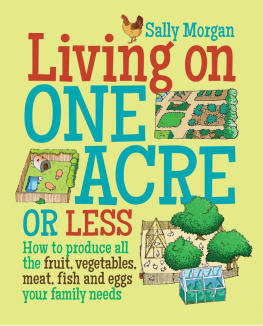
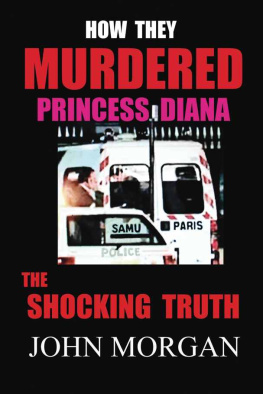

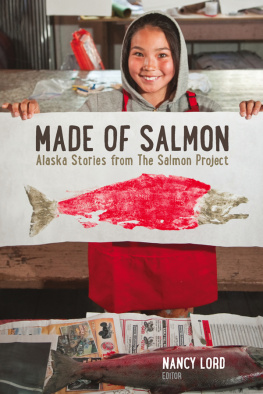
![Mila Mason - Salmon 365: Enjoy 365 Days With Amazing Salmon Recipes In Your Own Salmon Cookbook! (Best Seafood Cookbook, Seafood Soup Cookbook, Seafood Cookbook For Beginners, Grilled Seafood Cookbook) [Book 1]](/uploads/posts/book/288400/thumbs/mila-mason-salmon-365-enjoy-365-days-with.jpg)


